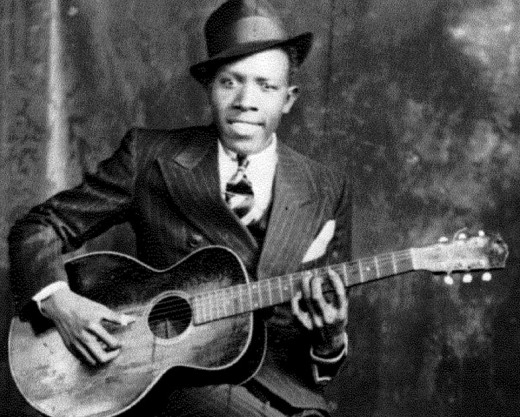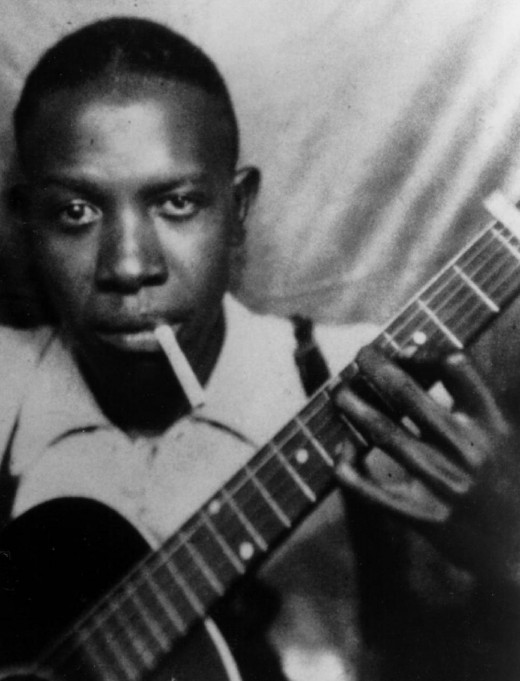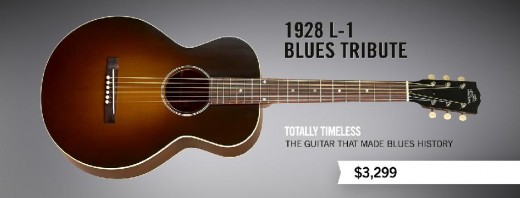The great Robert Johnson

Robert Johnson is as iconic as the day is long. You should never believe such things, but he's the US version of the guy who sold his soul to Satan in order to get mastery of a musical instrument. The legends of people trading souls to the dark one for gifts is ancient as the hills. There's no reason Johnson would attempt such a thing, or that such a thing is even remotely plausible to begin with. He'd had Son House as a teacher of guitar. Son House was not the sort to cotton to the devil, but what do I know? I know people like their legends.
There is a statue which states he had done the deal with the dark lord. Something written in stone isn't all it is cranked up to be. We Americans seemed to need such a tale, however; and Johnson's prowess on the acoustic steel string guitar inspired many another guitar playing legend. He only ever recorded twenty nine songs. One of them, of course, was about trading the metaphysical to old scratch for legendary skills.
Robert Johnson died at the age of twenty seven years a long time before that, too would be cool. He lived the same length of time as did Jimi Hendrix. Hendrix may have been Johnson reincarnated. Hendrix, however, got a lot more done. Johnson mostly bustled for bucks, and played in juke joints when he could. He died having experienced none of the fame his music brought. His fame was all posthumous.
In 1961 his 29 songs were re-released on an album titled, 'King of the Delta blues Singers.' There are many distinct styles of blues music, Johnson's was the Delta Blues. Rural black blues musicians often believed mastery of the blues would give them mastery of their woman of choice. Well, that isn't so surprising. Using music to woo an object of physical desire is also, as old as the hills.
Robert Johnson was well thought of by his peers. People interviewed about him often said he was a nice, but kinda strange guy. The deals with the devil tales seemed to have stemmed from Johnson having been well known to be a good harmonica player, but a terrible guitar player. He was thought to have been fairly embarrassing on the guitar up until a point where he disappeared for a while. The next time people saw him he suddenly had the guitar mastered.
The people who did know about Robert Johnson when he was alive, and after he'd mastered the guitar, those people say they respected him the most for his ability to seemingly be able to play something after hearing it for the first time. In other words, he was one with that rare gift of ears which can just hear and know where on a fingerboard to find the notes to play a thing. He was said to perform in any style you could think of. So Johnson was better than what the mere 29 recorded songs can show us. From what we do have, his guitar playing was frantic, his singing tortured with anxiety.
There are very few photos of Robert Johnson, here he is again with his Gibson and a cigarette

Take a look at Robert Johnson's hands. His fingers look like they're longer than the average person's are. Those are hands which were born to play a guitar.
You listen to his music, and you notice he plays a percussive lead rhythm sort of style. What I mean is, he's not hitting single notes very often. He's not strumming full chords all that often either. Almost everything he plays is two or more strings at once, but seldom does he strum a five or six string chord. It makes for a very full sounding accompaniment to his singing.
Johnson would often sing a line, then use his guitar to mimic a second singer in a call and response sort of style. B.B. King would learn this technique, and use it his entire career and life. Johnson very often used a slide, but he was such a busy player, moving around all over the fingerboard, he could trick a listener into thinking they were hearing more than one guitarist.
His singing style was just as advanced, nuanced, and influential as his guitar playing. People can try to copy either of his techniques, and never come close. Some people just have that unique gift, and Johnson had two of them.
He died in Mississippi of unknown causes. Some say he was poisoned, others say he died of syphilis. The year was 1938. Was Robert Johnson the father of rock and roll music? His style certainly would have been called that were he to only have lived a couple decades later. As it is he helped spawn countless influential bluesmen and rock and roll guitarists. There are many scholarly books on the subject of the man. His guitar of choice? It was a Gibson L-1.
Gibson 1928 L-1 Blues Tribute guitar

While Robert Johnson had spectacular talent, there can be no doubt his guitar played a big part in helping deliver that sound which inspired so many, and continues to do so today. The guitar was a Gibson L-1, and Gibson has recreated the L-1 of so many years ago so that you too can own a guitar like the King of the Delta Blues used to play. But this is really a recreation plus some new things, like electronics so as to plug into an amplifier.
In 1928 when Gibson used spruce for a guitar's soundboard, they used Adirondack spruce. Adirondack spruce is a premium wood today. You have to pay more for a guitar with an Adirondack soundboard. Usually upgrading from Sitka spruce to Adirondack spruce is a cost increase of around a thousand dollars. Gibson is thermally curing the wood before it is used, so as to mimic old wood. It is a general truth that older wood produces more sound, and Adirondack is often thought to produce more volume than other species of spruce.
The Gibson 1928 L-1 Blues Tribute is one of the finest new, small body acoustic electric guitars available today. Gibson uses German Plek technology to ensure their fretboards and frets are as accurately and perfectly done as is possible. The braces are scalloped, and all guitars this fine are going to be fragile works of art used to create further works of art.
Nitrocellulose lacquer is used for the finish. This is something expensive and labor intensive to apply, but it ensures the wood vibrates to its maximum capacity for sound production, and that the guitar shines impressively when polished. This guitar's width at the nut is wider than most, so it is important to know your hands are large enough to wrap around the neck. There are just twelve frets clear of the body here, and such guitars are known to project in a different sort of tonal manner than the now standard 14 frets clear of the body guitars do. The electronics are by L.R. Baggs, and these include a pickup and pre-amp. I'm surprised these aren't selling for more, but how long Gibson will produce them is anyone's guess.


 8:44 PM
8:44 PM
 Wesman Todd Shaw
Wesman Todd Shaw

0 comments:
Post a Comment